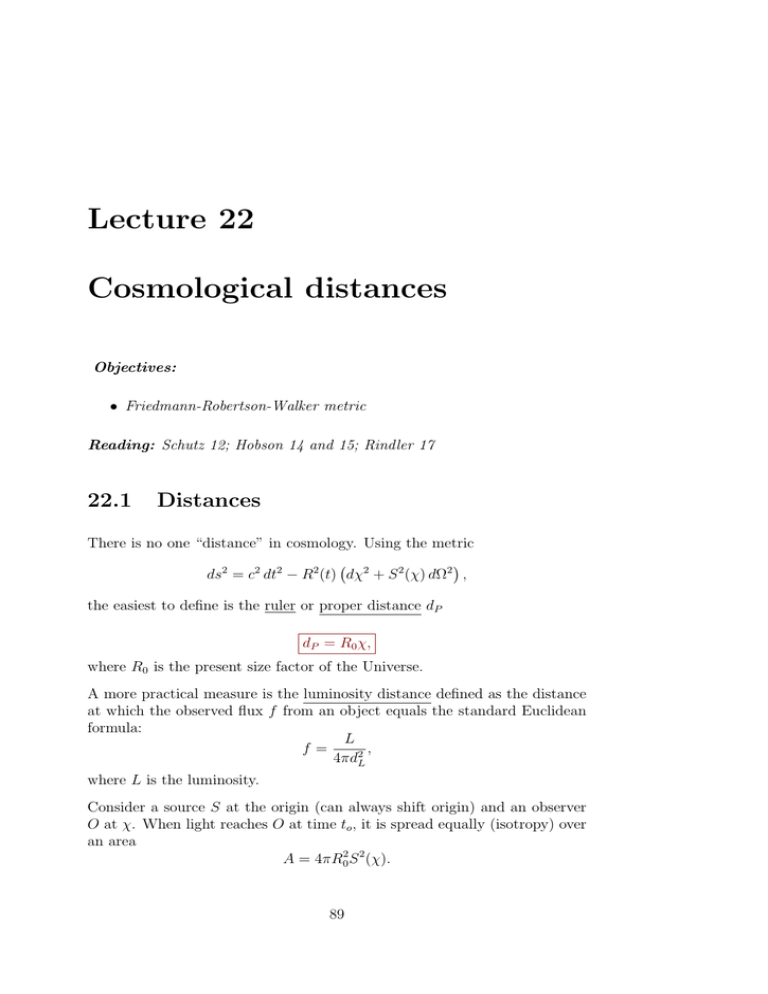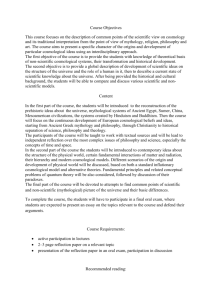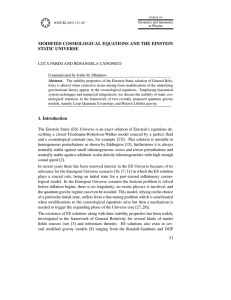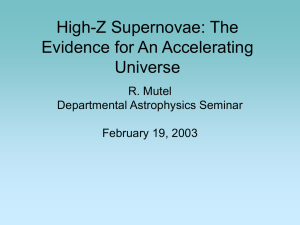Lecture 22 Cosmological distances 22.1 Distances
advertisement

Lecture 22 Cosmological distances Objectives: • Friedmann-Robertson-Walker metric Reading: Schutz 12; Hobson 14 and 15; Rindler 17 22.1 Distances There is no one “distance” in cosmology. Using the metric ¢ ¡ ds2 = c2 dt2 − R2 (t) dχ2 + S 2 (χ) dΩ2 , the easiest to define is the ruler or proper distance dP dP = R0 χ, where R0 is the present size factor of the Universe. A more practical measure is the luminosity distance defined as the distance at which the observed flux f from an object equals the standard Euclidean formula: L f= , 4πd2L where L is the luminosity. Consider a source S at the origin (can always shift origin) and an observer O at χ. When light reaches O at time to , it is spread equally (isotropy) over an area A = 4πR02 S 2 (χ). 89 LECTURE 22. COSMOLOGICAL DISTANCES 90 The flux observed is therefore f= L 4πR02 S 2 (χ)(1 + z)2 . The (1 + z)2 factor comes from the redshift which reduces both the energy and arrival rate of the photons. The R2 (t)S 2 (χ) comes from the angular terms of the FRW metric. Therefore dL = R0 Sk (χ)(1 + z). The angular diameter distance dA is defined such that α= l , dA where α is the angle subtended by an object of size l. Sketch: Figure: The angular size defined at emission is preserved during expansion because the photons travel along radial paths towards the origin. Photons travel from source to observer along radial paths. Angular size defined at time of emission. From the FRW metric, l = R(te )Sk (χ)α, and therefore dA = R(te )Sk (χ) = since 1+z = R0 Sk (χ) , 1+z R0 . R(te ) In each case we need χ which is connected to the time of emission te and observation t0 through Z t0 c dt . χ= te R(t) LECTURE 22. COSMOLOGICAL DISTANCES 91 We can replace t by z where 1+z = so dz = − and hence χ=− Z R0 , R R0 Ṙ dt, R2 0 cR2 1 dz, R0 Ṙ R z so, remembering H = Ṙ/R, R0 χ = Z 0 z c dz . H(z) Thus χ, and hence the distances, are sensitive to the expansion history of the Universe encoded in H(z). e.g. flux vs redshift (“Hubble diagrams”) of supernovae =⇒ a cosmological constant. 22.2 The future of our Universe We now believe that our Universe is 74% cosmological constant, 26% matter (5% baryonic). In the future Λ will dominate since ρM ∝ R−3 while ρΛ is constant, so the Friedman equation tends to ¶1/2 µ 8πG Ṙ = ρΛ R, 3 the curvature term being constant becomes negligible compared to the above terms. This equation describes a de Sitter universe in which there is only a cosmological constant. Clearly R = R0 exp(t/τ ), where t is measured from the present and ¶1/2 µ 3 = 1.6 × 1010 yr, τ= 8πGρΛ for our Universe. Outrunning a photon: consider a photon emitted at time t = te (counting from the present). By time t it will have reached comoving radius χ given by Z t Z t ¢ c cτ ¡ −te /τ c dt e − e−t/τ . = e−t/τ dt = χ(t) = R0 te R0 te R(t) LECTURE 22. COSMOLOGICAL DISTANCES 92 As t → ∞, the photon has reached a proper distance as measured in today’s Universe (R = R0 ) of dP = R0 χ = cτ e−te /τ . Implication: photons in a de Sitter unverse never catch up distant parts of the Universe. The later a photon is emitted, the shorter the distance it travels in today’s terms. Put differently, we see no photons that a galaxy at proper distance dP emitts after a time te = τ ln cτ . dP Were we to observe a clock in such a galaxy, we would see it get slower and slower, never quite making it to te . The galaxy meanwhile becomes increasing redshifted and ever fainter. This is an external event horizon in fact. As a consequence, in the future, all galaxies now in the Hubble flow away from us will disappear from our view, unless the “dark energy” driving the expansion runs out of steam.





